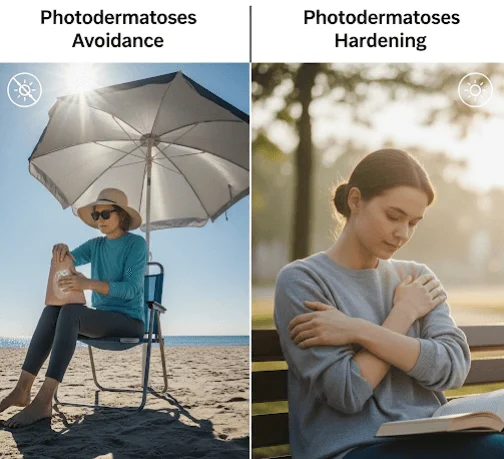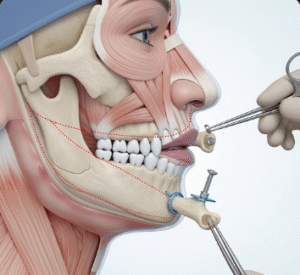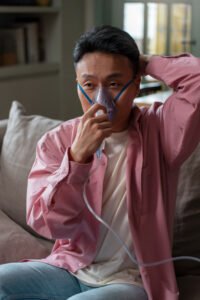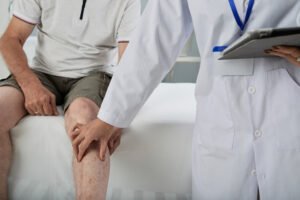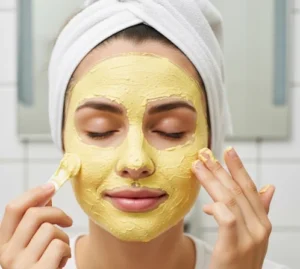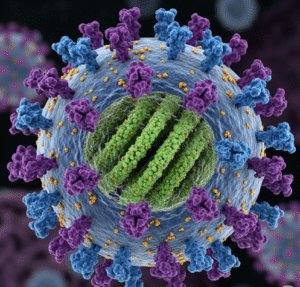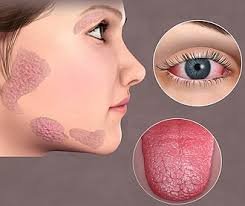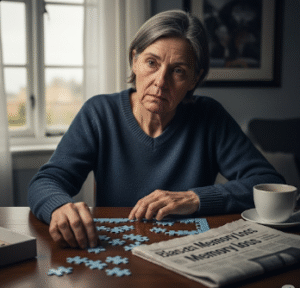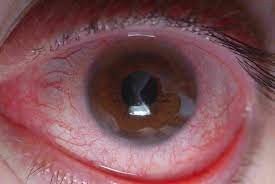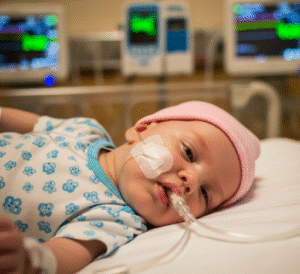Structured care for sun-sensitive skin conditions
What it is
Photodermatoses are a group of skin disorders triggered or worsened by exposure to ultraviolet (UV) or visible light. Common forms include:
- Polymorphous light eruption (PMLE) – itchy rashes appearing hours to days after sun exposure
- Chronic actinic dermatitis – persistent eczema-like reaction to light
- Solar urticaria – hives triggered within minutes of sunlight exposure
- Photoaggravated disorders – conditions like lupus or eczema worsened by UV radiation
Management of photodermatoses involves two pillars:
- Avoidance strategies – preventing excessive UV exposure with sunscreens, clothing, and lifestyle changes.
- Phototherapy hardening – controlled medical exposure to UV light that gradually builds tolerance in sensitive patients.
In Korea, dermatology clinics combine preventive counseling, advanced sunscreens, and precise phototherapy protocols, ensuring both skin health and quality of life.
Why it’s done
Photodermatoses avoidance and hardening therapy are recommended for:
✔ Symptom control – Preventing painful rashes, itching, or hives caused by sunlight.
✔ Daily functioning – Helping patients enjoy outdoor activities safely.
✔ Preventing secondary infections – Scratching inflamed skin increases infection risk.
✔ Cosmetic protection – Avoids pigmentation, scarring, or skin thickening from chronic reactions.
✔ Emotional support – Reduces anxiety and isolation often linked to sun sensitivity.
Alternatives
Management options vary depending on the severity of photodermatoses.
→ Strict sun avoidance – Staying indoors during peak UV hours, using wide-brimmed hats, sunglasses, and UV-blocking clothing.
→ High-SPF sunscreens – Broad-spectrum (UVA/UVB) creams reapplied every 2–3 hours outdoors.
→ Topical therapies – Corticosteroids or calcineurin inhibitors for flare management.
→ Oral medications – Antihistamines for solar urticaria; hydroxychloroquine or immunosuppressants for severe chronic conditions.
→ Phototherapy hardening – Controlled UV light exposure to increase skin tolerance.
Korean clinics prefer a combined approach, starting with avoidance and adding hardening phototherapy for patients who need greater outdoor flexibility.
Preparation
Before beginning avoidance strategies or phototherapy hardening, preparation is essential.
➤ Dermatologic assessment – Confirm diagnosis through history, exam, and sometimes phototesting (controlled UV exposure tests).
➤ Medical history – Check for autoimmune diseases, drug use, or prior reactions.
➤ Skin type evaluation – Determines sensitivity and starting phototherapy dose.
➤ Patient counseling – Education about sun safety and realistic outcomes.
➤ Baseline documentation – Photos or symptom diaries to track improvement.
How it’s done
Photodermatoses avoidance and hardening therapy follow a structured regimen.
➔ Avoidance methods –
- Daily use of high-SPF, broad-spectrum sunscreens.
- UV-blocking clothing and accessories.
- Window films or UV shields indoors.
- Behavior adjustments such as limiting outdoor time during peak sunlight hours.
➔ Phototherapy hardening –
- Conducted in dermatology clinics under supervision.
- Involves gradual exposure to controlled doses of UVB or UVA light.
- Sessions are typically 2–3 times per week over several weeks.
- Skin tolerance improves, reducing flare-ups during real sun exposure.
➔ Adjunctive care –
- Topical steroids or non-steroid creams after flare-ups.
- Oral antihistamines for itching.
- Moisturizers to maintain skin barrier strength.
In Korea, hardening regimens are carefully personalized with digital UV dose tracking for safety and accuracy.
Recovery
Recovery focuses on improved tolerance and reduced symptoms.
→ Most patients see reduced flare frequency within weeks of phototherapy hardening.
→ Sun avoidance habits become easier with structured education.
→ Children and adults regain confidence in participating in outdoor activities.
→ Ongoing skincare prevents relapses and maintains tolerance.
Complications
Though generally safe, possible complications include:
✔ Sunburn-like reactions if phototherapy doses are too high.
✔ Pigmentation changes – temporary tanning or darkening of treated areas.
✔ Skin dryness or itching after phototherapy.
✔ Long-term UV risks – theoretically increased skin aging or cancer risk, though doses are medically controlled.
✔ Incomplete response – Some patients may continue to experience flare-ups despite therapy.
In Korea, risks are minimized through precise dosing, dermatologist supervision, and integrated skincare.
Treatment options in Korea
Korea offers highly advanced dermatologic care for photodermatoses.
➤ Specialized photodermatology clinics – Equipped with UVA, UVB, and narrowband phototherapy machines.
➤ Tailored hardening regimens – Based on skin type, severity, and lifestyle needs.
➤ Cutting-edge sun protection – Access to innovative Korean sunscreens with lightweight, high-SPF formulations.
➤ Adjunctive therapies – Clinics often combine phototherapy with LED light care, hydration programs, or regenerative creams.
➤ Parental support – Pediatric patients with light sensitivity receive family counseling and child-safe regimens.
➤ Medical tourism readiness – Korean hospitals offer bilingual consultations and customized UV hardening schedules for international patients.
➤ Ongoing research – Korea contributes significantly to global studies on light-sensitive skin disorders and phototherapy protocols.
By seeking photodermatoses avoidance and hardening care in Korea, patients benefit from world-class dermatology, advanced UV therapies, and strong emphasis on safety and cosmetic outcomes.

